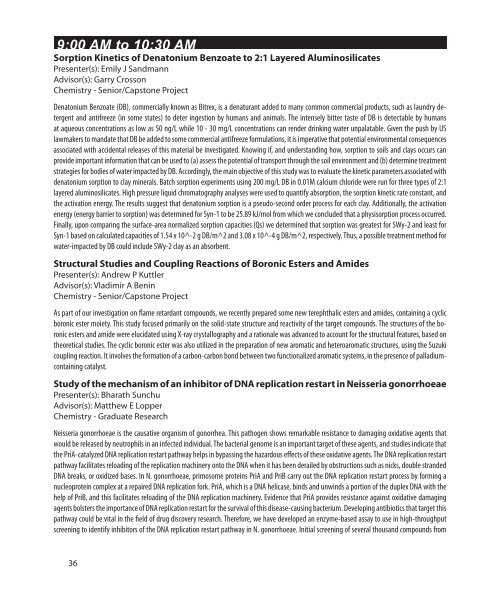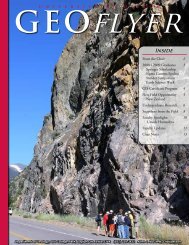Stander Symposium abstract book - University of Dayton
Stander Symposium abstract book - University of Dayton
Stander Symposium abstract book - University of Dayton
You also want an ePaper? Increase the reach of your titles
YUMPU automatically turns print PDFs into web optimized ePapers that Google loves.
9:00 AM to 10:30 AM<br />
Sorption Kinetics <strong>of</strong> Denatonium Benzoate to 2:1 Layered Aluminosilicates<br />
Presenter(s): Emily J Sandmann<br />
Advisor(s): Garry Crosson<br />
Chemistry - Senior/Capstone Project<br />
Denatonium Benzoate (DB), commercially known as Bitrex, is a denaturant added to many common commercial products, such as laundry detergent<br />
and antifreeze (in some states) to deter ingestion by humans and animals. The intensely bitter taste <strong>of</strong> DB is detectable by humans<br />
at aqueous concentrations as low as 50 ng/L while 10 - 30 mg/L concentrations can render drinking water unpalatable. Given the push by US<br />
lawmakers to mandate that DB be added to some commercial antifreeze formulations, it is imperative that potential environmental consequences<br />
associated with accidental releases <strong>of</strong> this material be investigated. Knowing if, and understanding how, sorption to soils and clays occurs can<br />
provide important information that can be used to (a) assess the potential <strong>of</strong> transport through the soil environment and (b) determine treatment<br />
strategies for bodies <strong>of</strong> water impacted by DB. Accordingly, the main objective <strong>of</strong> this study was to evaluate the kinetic parameters associated with<br />
denatonium sorption to clay minerals. Batch sorption experiments using 200 mg/L DB in 0.01M calcium chloride were run for three types <strong>of</strong> 2:1<br />
layered aluminosilicates. High pressure liquid chromatography analyses were used to quantify absorption, the sorption kinetic rate constant, and<br />
the activation energy. The results suggest that denatonium sorption is a pseudo-second order process for each clay. Additionally, the activation<br />
energy (energy barrier to sorption) was determined for Syn-1 to be 25.89 kJ/mol from which we concluded that a physisorption process occurred.<br />
Finally, upon comparing the surface-area normalized sorption capacities (Qs) we determined that sorption was greatest for SWy-2 and least for<br />
Syn-1 based on calculated capacities <strong>of</strong> 1.54 x 10^-2 g DB/m^2 and 3.08 x 10^-4 g DB/m^2, respectively. Thus, a possible treatment method for<br />
water-impacted by DB could include SWy-2 clay as an absorbent.<br />
Structural Studies and Coupling Reactions <strong>of</strong> Boronic Esters and Amides<br />
Presenter(s): Andrew P Kuttler<br />
Advisor(s): Vladimir A Benin<br />
Chemistry - Senior/Capstone Project<br />
As part <strong>of</strong> our investigation on flame retardant compounds, we recently prepared some new terephthalic esters and amides, containing a cyclic<br />
boronic ester moiety. This study focused primarily on the solid-state structure and reactivity <strong>of</strong> the target compounds. The structures <strong>of</strong> the boronic<br />
esters and amide were elucidated using X-ray crystallography and a rationale was advanced to account for the structural features, based on<br />
theoretical studies. The cyclic boronic ester was also utilized in the preparation <strong>of</strong> new aromatic and heteroaromatic structures, using the Suzuki<br />
coupling reaction. It involves the formation <strong>of</strong> a carbon-carbon bond between two functionalized aromatic systems, in the presence <strong>of</strong> palladiumcontaining<br />
catalyst.<br />
Study <strong>of</strong> the mechanism <strong>of</strong> an inhibitor <strong>of</strong> DNA replication restart in Neisseria gonorrhoeae<br />
Presenter(s): Bharath Sunchu<br />
Advisor(s): Matthew E Lopper<br />
Chemistry - Graduate Research<br />
Neisseria gonorrhoeae is the causative organism <strong>of</strong> gonorrhea. This pathogen shows remarkable resistance to damaging oxidative agents that<br />
would be released by neutrophils in an infected individual. The bacterial genome is an important target <strong>of</strong> these agents, and studies indicate that<br />
the PriA-catalyzed DNA replication restart pathway helps in bypassing the hazardous effects <strong>of</strong> these oxidative agents. The DNA replication restart<br />
pathway facilitates reloading <strong>of</strong> the replication machinery onto the DNA when it has been derailed by obstructions such as nicks, double stranded<br />
DNA breaks, or oxidized bases. In N. gonorrhoeae, primosome proteins PriA and PriB carry out the DNA replication restart process by forming a<br />
nucleoprotein complex at a repaired DNA replication fork. PriA, which is a DNA helicase, binds and unwinds a portion <strong>of</strong> the duplex DNA with the<br />
help <strong>of</strong> PriB, and this facilitates reloading <strong>of</strong> the DNA replication machinery. Evidence that PriA provides resistance against oxidative damaging<br />
agents bolsters the importance <strong>of</strong> DNA replication restart for the survival <strong>of</strong> this disease-causing bacterium. Developing antibiotics that target this<br />
pathway could be vital in the field <strong>of</strong> drug discovery research. Therefore, we have developed an enzyme-based assay to use in high-throughput<br />
screening to identify inhibitors <strong>of</strong> the DNA replication restart pathway in N. gonorrhoeae. Initial screening <strong>of</strong> several thousand compounds from<br />
36

















